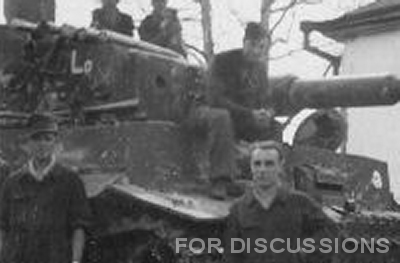About this detail of the Tiger
All the Tigers built from this kit participated in the third battle of Kharkov in early 1943. The terrain was snow-covered and therefore most German armour was camouflaged in white, but the kit's decals support some colourful paint schemes.
All Tigers at the battle were new, and arrived from the factory painted in RAL8000. The crews were supplied with RAL 7008 to create a camouflage scheme. Whether they did so we are not sure, because most units whitewashed their Tigers at or before their arrival in the field.
The "Grossdeutschland" Tiger company, however, did not apply whitewash at any time. Their Tigers retained the first "Tropical" scheme, using both colours, throughout the Kharkov operation and into the summer (except, in some cases, their turret bins ).

At some point "Grossdeutschland" were issued the newer "Tropical" colour RAL 8020, and although it was not compatible with the colour of their tanks, it was the only paint that they were authorised to use. Therefore, when they needed to change their turret IDs, they overpainted the old digits with RAL 8020. This is represented in the kit's Tiger "7".

The unit "Das Reich" whitewashed their Tigers, and Tiger "832" on the decal sheet could be built with a white finish. Photos show that this whitewash was not solidly applied on "832". It gradually wore off the gun, the upper surfaces and in particular the turret bin.

But the kit's painting guide depicts "832" at a slightly later time, when the crew had diligently scrubbed off almost all of their tank's whitewash, leaving it with an unusually pale version of RAL8000.

A Tiger that has nothing to do with Kharkov is also hidden on the kit's "basic" decal sheet. This tank served near Leningrad and is known for its unusual "cow pattern".
The additional 4 schemes in the "bonus" release of the kit are mostly whitewashed Tigers of various units. But one of them is very unusual.

This Tiger of "Totenkopf" was smeared with narrow strokes of dark mud, on top of its winter whitewash. The crew then gave the Tiger a name, "Lo", and applied the deaths-head symbol which is very rarely seen on Tigers.